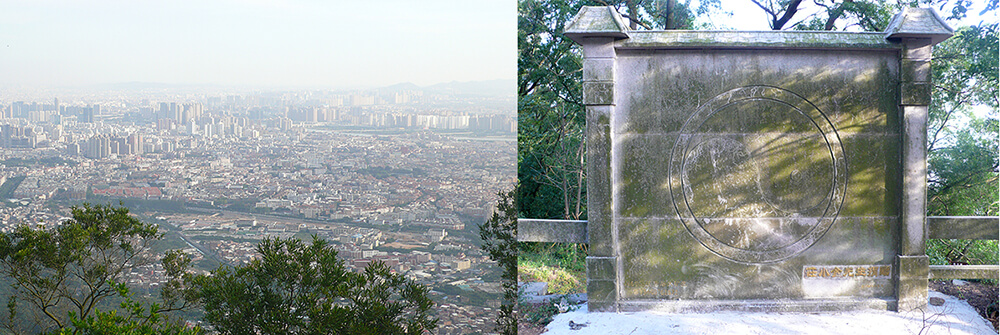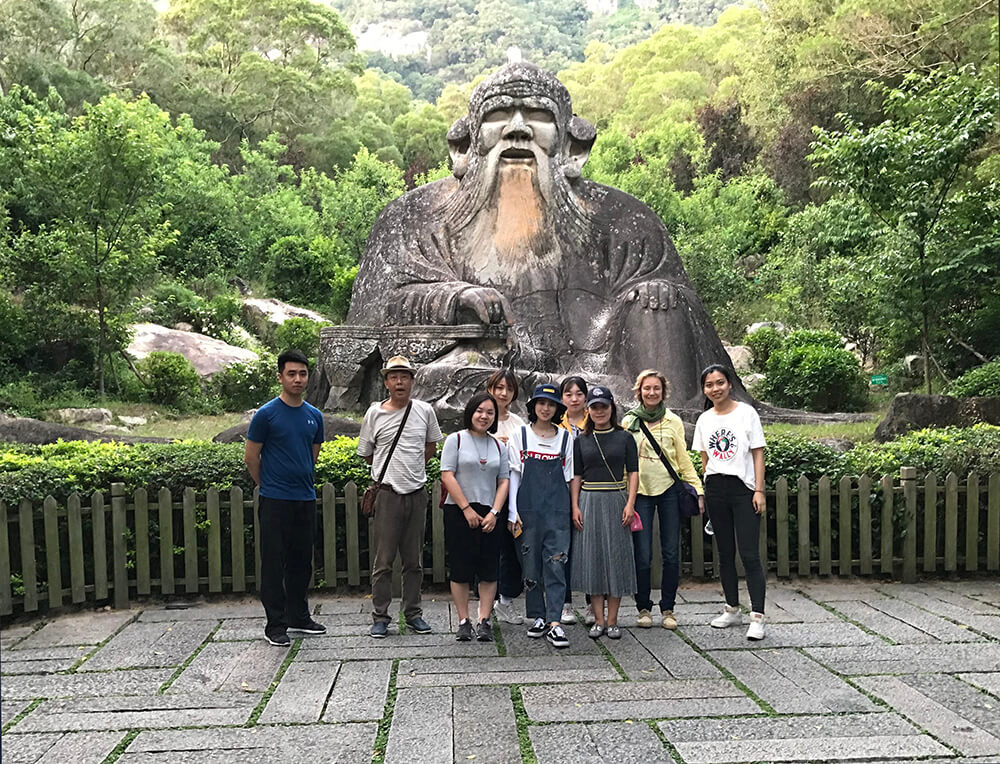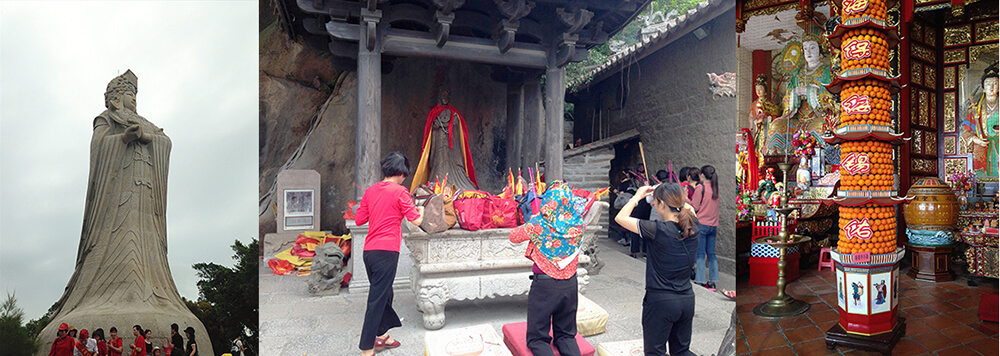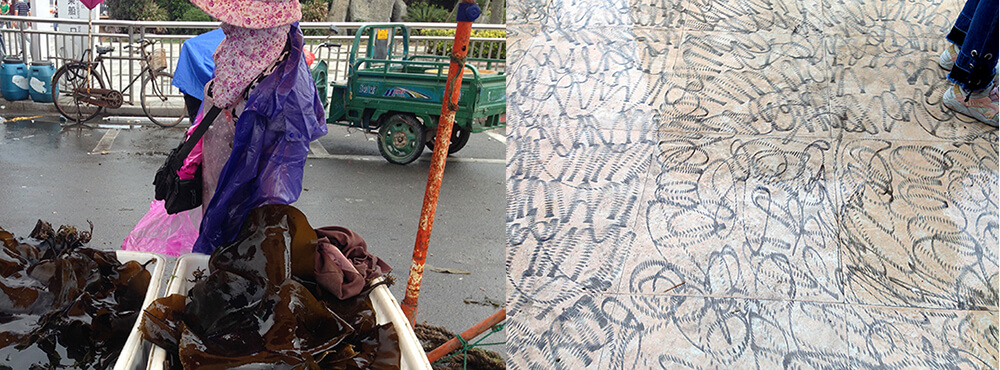Excursion to Quanzhou and Mazu’s birthday
Saturday, early in the morning a small group awaited me at the gate of the university: Professor Li, five Masters design students, two graduated design students and a driver. Beforehand, during the preparations, I had already been in contact with some of them through WeChat; with Pei who originally is from the region we’ll visit, and who organised the trip; and also with Sucy and Yi who can speak fairly good English, and would assist and translate for me during the whole weekend.
The rented minibus was not new, nor very fast or with terrific suspension, but big enough for the ten of us us and with good air conditioning; luckily, because the weather was hot. We headed north, where our first stop was at the Cai clan Mansions, just outside Quanzhou.

The Cai clan arrived here some 1.700 years ago from the north, and still live here in the group of houses we visited, though the houses are newer, about 200 years old. They have beautiful roofs and interesting decorations from different periods; especially woodworks and stone carvings, but also curious communist stamps, old photos and recent plastic furniture. When we arrived it was almost midday, very hot and the place looked deserted, but a guide awaited us, showed us around and let us enter a few houses. Sometimes it felt awkward seeing people’s laundry and dishes. In general the habitants were absent. Now and then I saw some kids in a side room, or somebody watering plants in a court yard. The colourful tiles on many floors reminded me of floors in Barcelona. The guide said they probably were imported from the Philippines. The houses were built using Feng shui and Wushu, which is expressed in the directions of the rooms and the choice of the materials.
The students translated some of the symbolism of the decorations for me, as: monkey, bear, deer and peach that all mean long life. A Chinese grandmother gets peach cake for her birthday :-). The phoenix is king of the birds. The swallow means you’ll return home, bamboo stands for modesty and lotus for elegance. The powerful scaled dragon brings fertility. Often the symbolic meaning of an image goes through the character of it’s name; like the character for lion is shì which also means house, so lion stands for house. There are also many writings on the walls of the houses. Often they are moral expressions, like about the importance of tolerance. I was delighted to be able to travel with Chinese people who generously shared with me what they knew.
Then we drove towards the center of Quanzhou; first through a half industrial, half rural area, then through a thick ring of skyscrapers and then, after passing a river, into a lively old town with red brick houses, scooters on gasoline, small shops and fruit stalls.

After lunch we visited the beautiful Kayan Buddhist temple with two ancient Buddhist pagodas. Then we wondered a bit through town, entering some of the many ceramics shops on West Street. In an outdoor market I bought two small graphic novels on which I plan to draw. We all ate ice creams except my two helpers who told me they never eat anything cold during their periods. It keeps intriguing me in China, ultra-modernity mixed with ancestral customs.
We visited the amazing complex of the impressive 1.000 year old Qingying Mosque. Since that period there are Muslims here. The places were quiet and peaceful, well kept and with beautiful shady gardens.
It was almost five when we headed to Mount Qing Yuan, on the outskirts of the town, my proposal for the program, just still in time to catch the last obligatory bus upwards. It darkens early compared to Europe, around 18:30h. Qing Yuan Shan is known as a Taoist mountain. The last bit upwards we walked. The views were stunning.

Since over thousand years hermits have lived on this mountain. There are beautiful trees and rocks, some with inscriptions. Around the various old temples are many sculptures, including the largest statue of Lao Zi in the world.

After descending we drove to Putian, Pei’s hometown, where we had dinner in a private room of a large restaurant. Amongst many other things delicious sea worm jelly and leathery jellyfish.
When we arrived late at our hotel the receptionist refused to give me a room. Her computer didn’t accept my foreign passport and she was not of the flexible kind. But Pei made some calls and in no time another hotel was found. Sucy and Yi came with me and Pei brought us. I was quite impressed by their fluent organisation and solidarity. The new hotel was posh. All on this trip was included in the budget, less than a €100 a person, so I was relieved when I heard we got a discount because Pei knows the owners. The room was state of the art design and the breakfast buffet extensive :-).

Next morning we headed for Meizhou Island. That whole week the island was celebrating the birthday of Mo, a girl born about 1.100 years ago; probably on the island and if not on the mainland near to it. She’s famous now as the goddess Mazu. It’s a widely spread cult with many worshippers, specially in Taiwan, Hongkong, Borneo and south China.
There are different versions of her life. I like this one: She was called Mo, which means silence, because as a baby she didn’t cry and as a young child she didn’t speak. She began to talk at four and immediately spoke fluently and was able to read too. Soon she knew everything. People sought her for her wisdom. At twelve she began to go out and help people; she visited the sick, the poor; taught children. At 18 she started to do miracles. She saved many fishermen at sea and cured many sick people. At 27 she climbed up the mountain and continued climbing up the clouds and disappeared from the earth. From then on she’s the goddess Mazu, patron of the seas.

She dressed in red, and this is what her worshippers wear on her birthday. The traditional dress of Meizhou women are trousers with one red leg and one black one, grieving her early disappearance. They wear their hair elegantly in a knot in the shape of a sail.
I was impressed with the quantity of worshippers and with the passion with which they lit incense, threw bamboo sticks on the floor, prayed, and carried their own villages’ statues of Mazu in small groups up the many stairs, from temple to temple. I was told that the amount of stairs also had been determined by throwing bamboo stones, ‘qiān’.
Each temple on Meizhou has its own Mazu; of gold, marble, jade. She’s guarded by demigods and often surrounded by foods. The biggest Mazu is a stone one in the open air. Professor Li told us he assisted about 30 years ago in making this huge sculpture, as a summer job when he was a student.
Afterwards we had lunch in a more quite part of the island, and strolled around a bit. We visited a half closed food market where some dried octopus was bought – a speciality of the island. One of the shops we passed had an amazing porch floor; as if it was decorated through skating. At the ferry station a woman, protected against the sun with many cloths, sold huge pieces of seaweed.

Back at the main land we drove to Xianyou. There we visited an enormous and extremely luxury crafts mall. High ceilings, giant spaces, marble floors, glass elevators, fountains, goldfish, pretty uniformed hostesses; all to sell classical Chinese furniture and lots of stone- and wood carvings, most of it from this region, handmade and very expensive. In the centre of many shops stood a table with a tea set to accompany negotiations.

Tradition, kitsch, craft, art; Seeing all these beautifully made things made me question these concepts and their boundaries. I specially enjoyed the woodcarvings that consciously use the shape of the original branch they are carved from, integrating it in their content. Still, the atmosphere in the mall wasn’t cosy and I was happy when we left and moved on to the furniture makers village of Bangtou.
It was already evening when we arrived and the shops were closed. Only from one came noise, and since its door was open we entered. Cautiously approaching the noise we saw computer steered machines making fine woodcarvings. No person in sight. mmm…

Strolling through the village we found a beautiful old neighbourhood, vegetable gardens in front with a big red flag, where we entered a small temple, more a mix of a temple and a store house actually. There were bamboo sticks and brooms, and a small altar. An elderly couple explains to us that this is the old family temple of their clan, the Yán, who arrived here centuries ago from north China. They told proudly that a famous general and calligrapher: Yán Zhēn Qíng from the Tang period, was from their family. The students knew his work and we were all happy that by coincidence we found this friendly place.

A former student of Professor Li, and his wife, both art teachers in a nearby town, had accompanied us since the crafts mall and afterwards invited us to dinner in Putian. It was late when we drove back to Xiamen. It was an intensive and wonderful weekend. Afterwards I keep in contact with some of my companions.